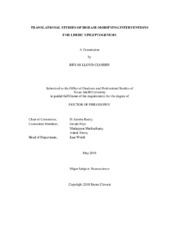| dc.description.abstract | Epilepsy is characterized by the occurrence of repeated unprovoked seizures. Currently there is little understanding of the pathophysiological changes in epileptogenesis, the process by which a normal brain is turned into an epileptic one. Therefore, research providing further insight to mechanistic changes observed in epilepsy and epileptogenesis is a critical step in formulating new therapeutic strategies. Temporal lobe epilepsy, arising from insult or injury to the limbic system, is one of the most common types of epilepsy. The hippocampus is a critical structure for epileptogenesis. Epilepsy is associated with marked alterations in the structure and function of GABA-A receptors in the hippocampus. Neurosteroids are endogenous steroids present in the brain that modulate neuronal excitability through interaction with GABA-A receptors. This class of neurosteroids includes allopregnanolone, THDOC, and related 5-pregnane derivatives. Although neurosteroids are potent anticonvulsants, the precise role of neurosteroids in epileptogenesis remains poorly understood.
The main objective of this dissertation was to understand the role of endogenous neurosteroids and their synthetic analogs in limbic epileptogenesis using a combination of pharmacological, behavioral, and morphological techniques. We utilized two distinct models involving electrical kindling and chemoconvulsant-induced epileptogenesis, utilizing transgenic mouse strains such as GABA -subunit knockout mice (KO). Our studies suggest KO mice are prone to faster epileptogenesis, increased seizure susceptibility, and altered sensitivity to antiepileptic drugs (AEDs). Our studies provide evidence for alterations in extrasynaptic GABA-A receptors and increased neurosteroid sensitivity in a mouse catamenial epilepsy model. Neurosteroids may exhibit disease-modification in halting the epileptogenesis. We used a KO mouse model and uncovered the extrasynaptic GABA-A receptor mechanisms in the antiepileptogenic potential of natural and synthetic neurosteroids. Overall, we demonstrated that a targeted increase in neurosteroid levels elevates synaptic and tonic inhibition within the limbic areas, leading to network shunting and reduction in epileptogenesis. | en |


